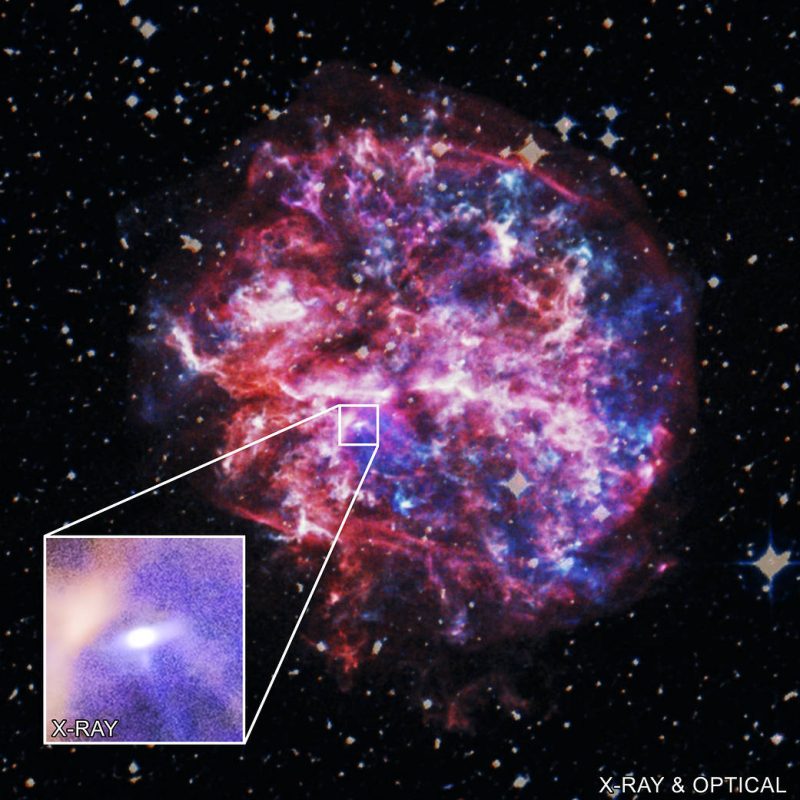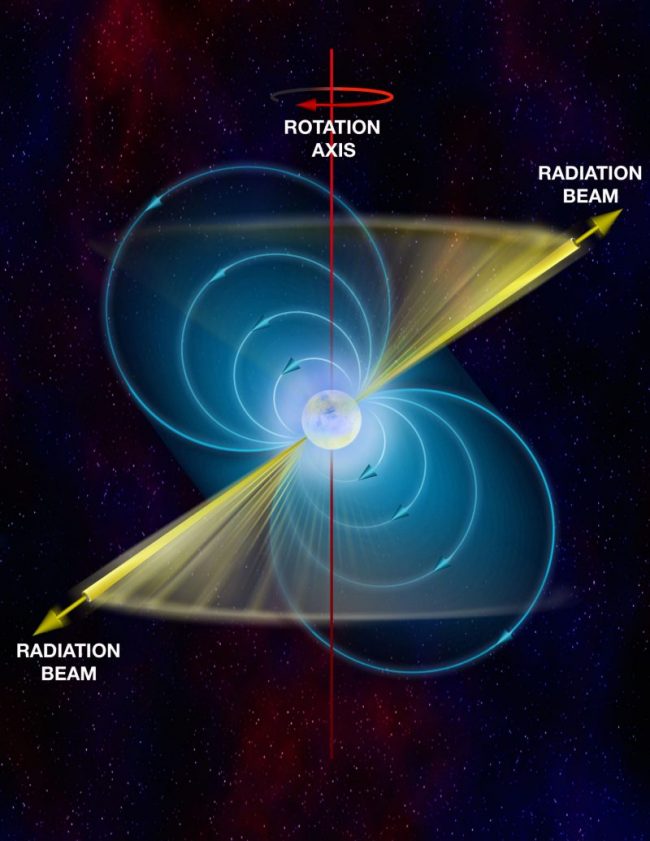
When a massive star explodes as a supernova at the end of its life, its core can collapse into a tiny and superdense object with not much more than our sun’s mass. These small, incredibly dense cores of exploded stars are neutron stars. They’re among the most bizarre objects in the universe.
A typical neutron star has about 1.4 times our sun’s mass. And they can range up to about two solar masses. Now consider that our sun has over 100 times Earth’s diameter. In a neutron star, all that mass is squeezed into a sphere that’s only about 12-25 miles (20-40 km) across, or about the size of an earthly city.
So perhaps you can see that neutron stars are very, very dense! A tablespoon of a neutron star material would weigh more than 1 billion U.S. tons (900 billion kg). That’s more than the weight of Mount Everest, Earth’s highest mountain.

Last chance to get a moon phase calendar! Only a few left. On sale now.
Here’s how a neutron star forms.
Throughout much of their lives, stars maintain a delicate balancing act. Gravity tries to compress the star while the star’s internal pressure exerts an outward push. And nuclear fusion at the star’s core causes the outer pressure. In fact, this fusion burning is the process by which stars shine.
In a supernova explosion, gravity suddenly and catastrophically gets the upper hand in the war it has been waging with the star’s internal pressure for millions or billions of years. With its nuclear fuel exhausted and the outward pressure removed, gravity suddenly compresses the star inward. A shock wave travels to the core and rebounds, blowing the star apart. This whole process takes perhaps a couple of seconds.
But gravity’s victory is not yet complete. With most of the star blown into space, the core remains, which may only be twice our sun’s mass. Gravity continues to compress it, to a point where the atoms become so compacted and so close together that electrons are violently thrust into their parent nuclei, combining with the protons to form neutrons.
Thus the neutron star gets its name from its composition. What gravity has created is a superdense, neutron-rich material – called neutronium – in a city-sized sphere. The exact internal structure of this sphere is the subject of much debate. Current thinking is that the star possesses a thin crust of iron, perhaps a mile or so thick. Under that, the composition is largely neutrons, taking various forms the further down in the neutron star they are located.
It’s all about mass.
If, after the supernova, the core of the star has enough mass, scientists believe that the gravitational collapse will continue, and a black hole will form instead of a neutron star. In terms of mass, the dividing line between neutron stars and black holes varies by sources. Typically, astronomers consider the mass of a neutron star to range from 1.4 to 2.9 solar masses. Then, if the collapsed core has more than three solar masses it becomes a black hole.
What are the properties of a neutron star?
Because neutron stars are so dense, they have intense gravitational and magnetic fields. The gravity of a neutron star is about a thousand billion times stronger than that of the Earth. Thus the surface of a neutron star is exceedingly smooth; gravity does not permit anything tall to exist. Neutron stars may have “mountains”, but they are only inches tall.
Neutron stars with abnormally strong magnetic fields are known as magnetars. The origin of these abnormal stars with ultra-powerful magnetic fields is unknown.
Unimaginably violent neutron star collisions, one of which was detected in 2017 by the LIGO gravitational wave observatories, are thought to be where heavy elements like gold and platinum are created. And that’s because normal supernovae are not thought to generate the requisite pressures and temperatures.
Neutron stars are also thought to be responsible for several little-understood phenomena, including the mysterious Fast Radio Bursts (FRBs) and the so-called Soft Gamma Repeaters (SGRs).
A neutron star does not generate any light or heat of its own after its formation. Over millions of years its latent heat will gradually cool from an initial 600,000 degrees Kelvin (1 million degrees Fahrenheit), eventually ending its life as the cold, dead remnant of a once-glorious star. It’s estimated there are more than a hundred million neutron stars in our Milky Way galaxy, but many will be too old and cold to be easily detected.
Pulsars: How we know about neutron stars.

Although neutron stars were long predicted in astrophysical theory, it wasn’t until 1967 that the first was discovered, as a pulsar, by Dame Jocelyn Bell Burnell. Since then, we know of hundreds more, including the famous pulsar at the heart of the Crab Nebula, a supernova remnant observed by the Chinese in 1054.
On a neutron star, intense magnetic fields focus radio waves into two beams firing into space from its magnetic poles, much like the beam of a lighthouse. If the neutron star is oriented precisely so that these beams become visible from our earthly viewpoint, we see flashes of radio light at regular and extremely exact intervals. Neutron stars are, in fact, the celestial timekeepers of the cosmos, their accuracy rivaling that of atomic clocks.
Neutron stars rotate extremely rapidly, and we can use the radio beams of a pulsar to measure just how fast. The fastest-rotating neutron star yet discovered rotates an incredible 716 times per second, which is about a quarter of the speed of light.
Read more about Jocelyn Bell Burnell, who discovered pulsars

Sci fi alert!
“Dragon’s Egg” by Robert L. Forward (out of print) depicts the imaginary inhabitants living on the surface of a neutron star. Claudia commented: “They were tiny and dense (of course) and lived at a tremendous speed. It’s been a while, but I remember it as a good read.” Andy added: “Yes, I remember that book! Very entertaining. It’s incredible to think that if the surface of a neutron star slips by as little as a millimeter, it causes a starquake.”
More resources on neutron stars:
Read more: Introduction to neutron stars
Five extreme facts about neutron stars
Read more: How high are pulsar mountains?
Bottom line: Neutron stars are the collapsed cores of formerly massive stars that have been crushed to an extreme density by supernova explosions. A neutron star isn’t as dense as a black hole, but it’s denser than any other known type of star.











